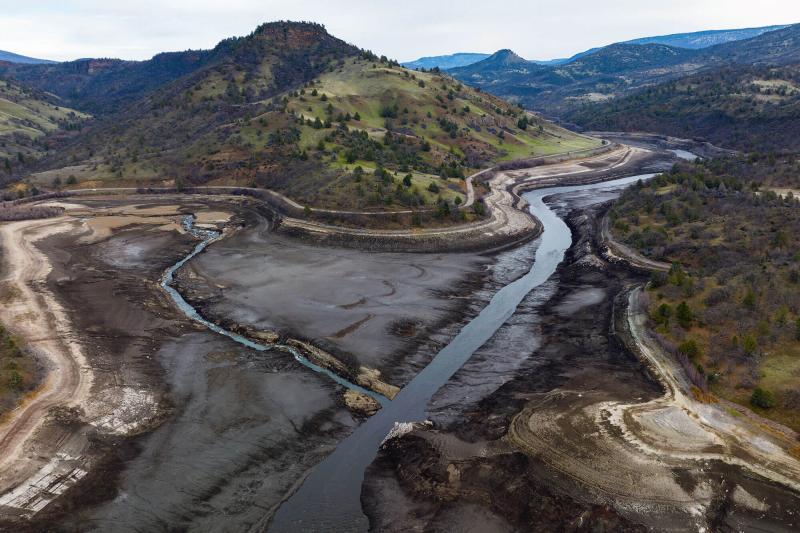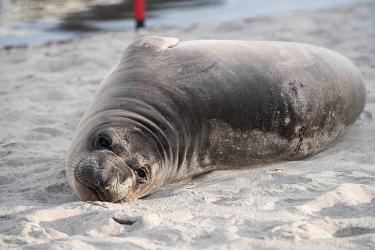The Klamath River is making the most of recent precipitation to rapidly reshape itself by removing decades worth of sediment accumulated behind dams now slated for removal. With the reservoirs behind the dams now empty, the river is transporting the sediment downstream while it is still wet and mobile.
NOAA Fisheries and the Bureau of Reclamation are working with tribes and other basin partners to release water from Link and Keno dams farther upstream through March and April. Starting this week, releases will create a flushing flow that peaks at approximately double the current river volume. The pulse will last for a week while managers monitor water quality. Additional releases will be conducted weekly with potentially higher peaks determined through monitoring and adaptive management. These variable flows will pick up the sediment and flush it downstream and into the ocean.
The next few months offer the river its best opportunity to move the sediment that had built up behind the dams over the last 60 to 100 years. That will jump-start recovery of the once-prolific salmon-producing river’s natural configuration and channels. It’s an early step in the nation’s largest ever dam removal and river restoration project.
“We want to give the river as much chance as we can to do its work while the sediment is ready to move,” said Jim Simondet, Klamath Branch Supervisor in NOAA Fisheries’ West Coast Region. He said the agency has coordinated with other agencies and tribes on a technical team that is using real-time information from river gauges to manage flows. The goal is to maximize the amount of sediment moving downriver while reducing risk to fish released from hatcheries and others migrating in the river.
Biologists Anticipated Turbidity
The river’s transport of sediment is an important part of the strategy to restore the Klamath. The river was long slowed by dams that turned its waters into a series of stagnant reservoirs. Poor water quality in the reservoirs sometimes killed fish and fueled harmful parasitic outbreaks downstream. Removing the three remaining dams (one has already been removed) will reopen 400 miles of river to salmon that once spawned along its course by the thousands. The loss of juvenile salmon from a state fish hatchery last week was unrelated to turbidity.
We conducted a consultation on the dam removal under the Endangered Species Act. It anticipated that sediment mobilizing in the first months of the dam removal would muddy the river, as turbidity naturally rises with higher winter flows. Our biological opinion expected the turbidity to have some short-term impacts on fish this year. We anticipated the turbidity would provide much greater long-term benefits to future generations of fish, increasing their populations overall. The strategy concentrates the movement of sediment over the next few months, avoiding impacts on fish spawning and hatching in future years.
“The river is undoing a century of being impacted by these dams, and that may look messy right now,” said Shari Witmore, a fisheries biologist in NOAA Fisheries’ Klamath Branch. “It’s moving all that sediment faster and more efficiently than we ever could, so what we are seeing is a very good thing.”
Rivers Recover Quickly
Other dam removal projects have seen rivers quickly reclaim their ground and begin to recreate habitat important to salmon, steelhead, and other aquatic species. This has often happened far ahead of expectations. Turbidity, oxygen levels, and other indicators of water quality in the Klamath River have remained within expected levels for the early stages of river restoration.
Project partners are coordinating with the Klamath River Renewal Corporation to avoid impacts of the flows on the Corporation’s upcoming work to complete the dam removals. Pending final approvals from the Federal Energy Regulatory Commission, the Renewal Corporation will begin removing the dams in May or when river conditions allow. By then the risk of high spring flows will have passed.
“There has been good communication and coordination between the agencies and tribes to share information and provide feedback,” Simondet said. “We are working in real time to make the most of this great opportunity to restore the river. It may take time, but we look forward to a river that again contributes to the West Coast economy, environment, and treaty obligations to tribes as it once did.”



